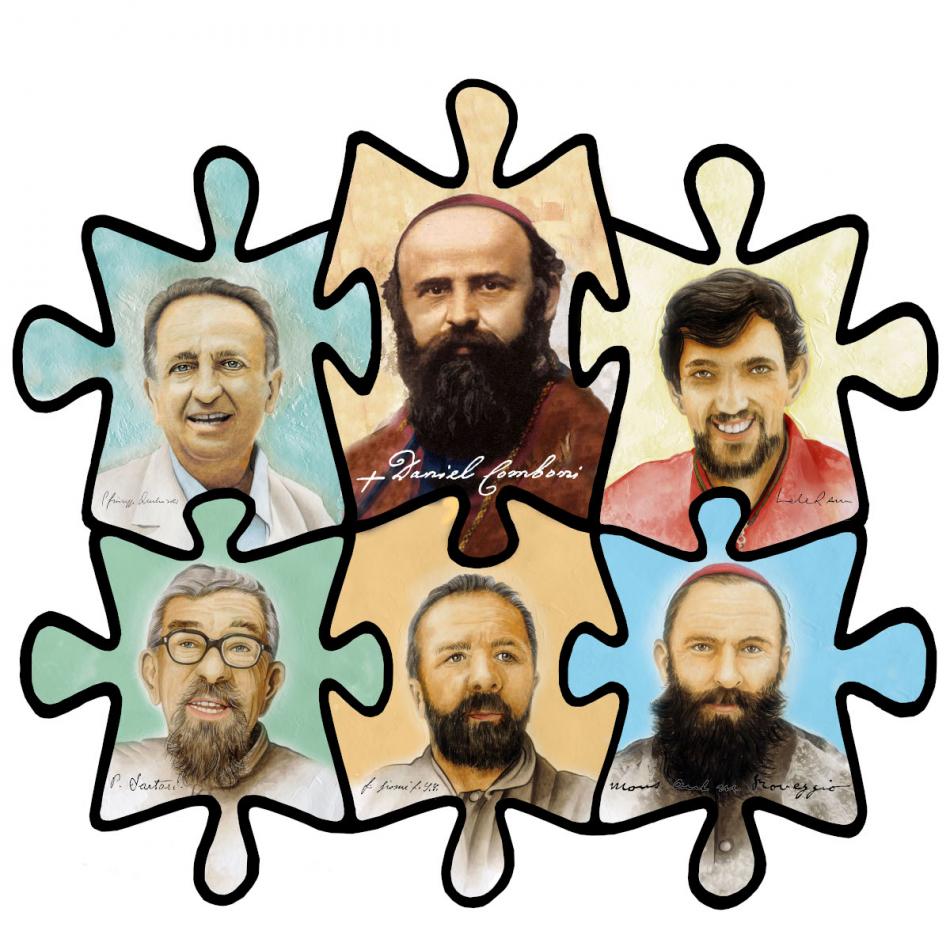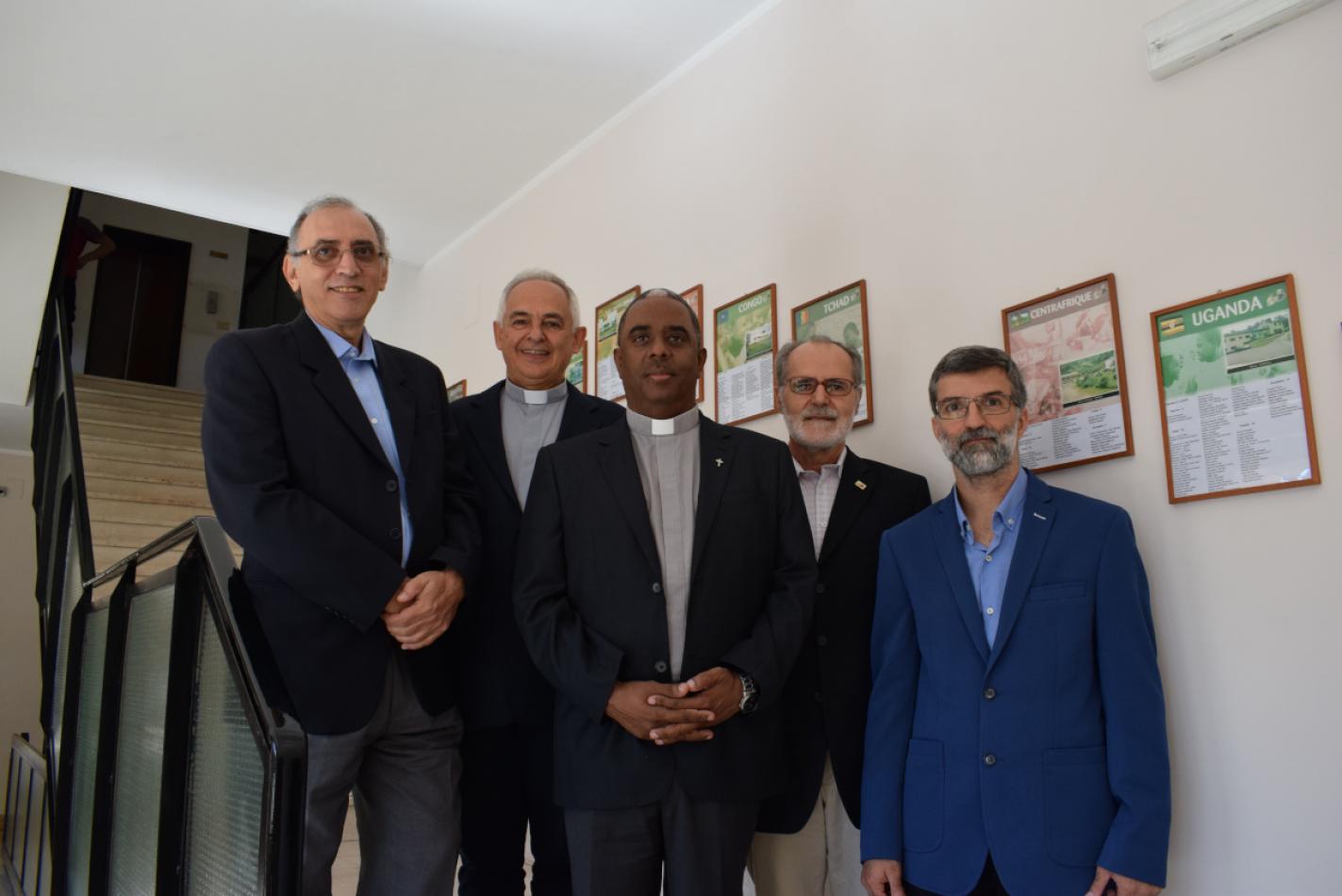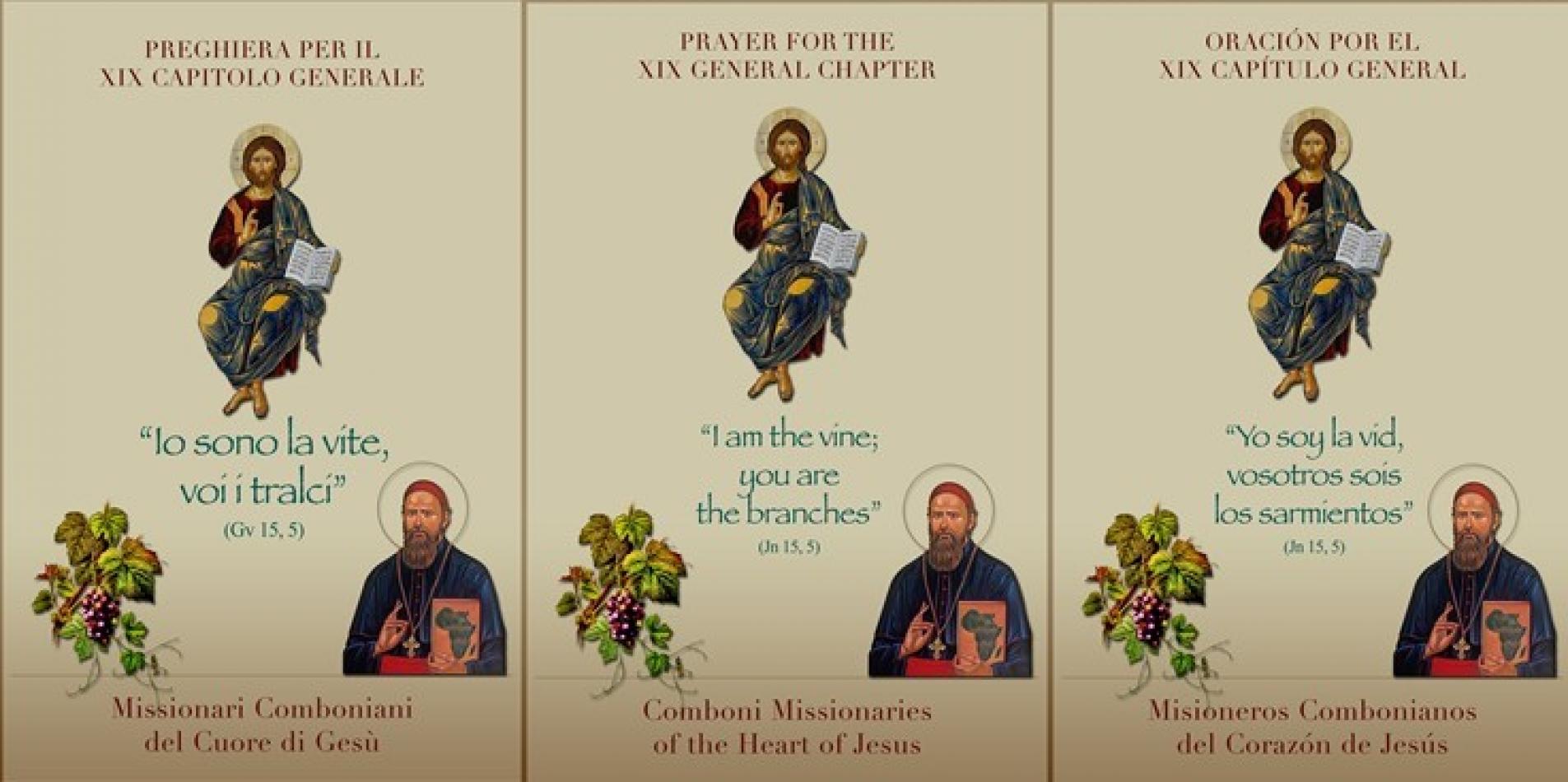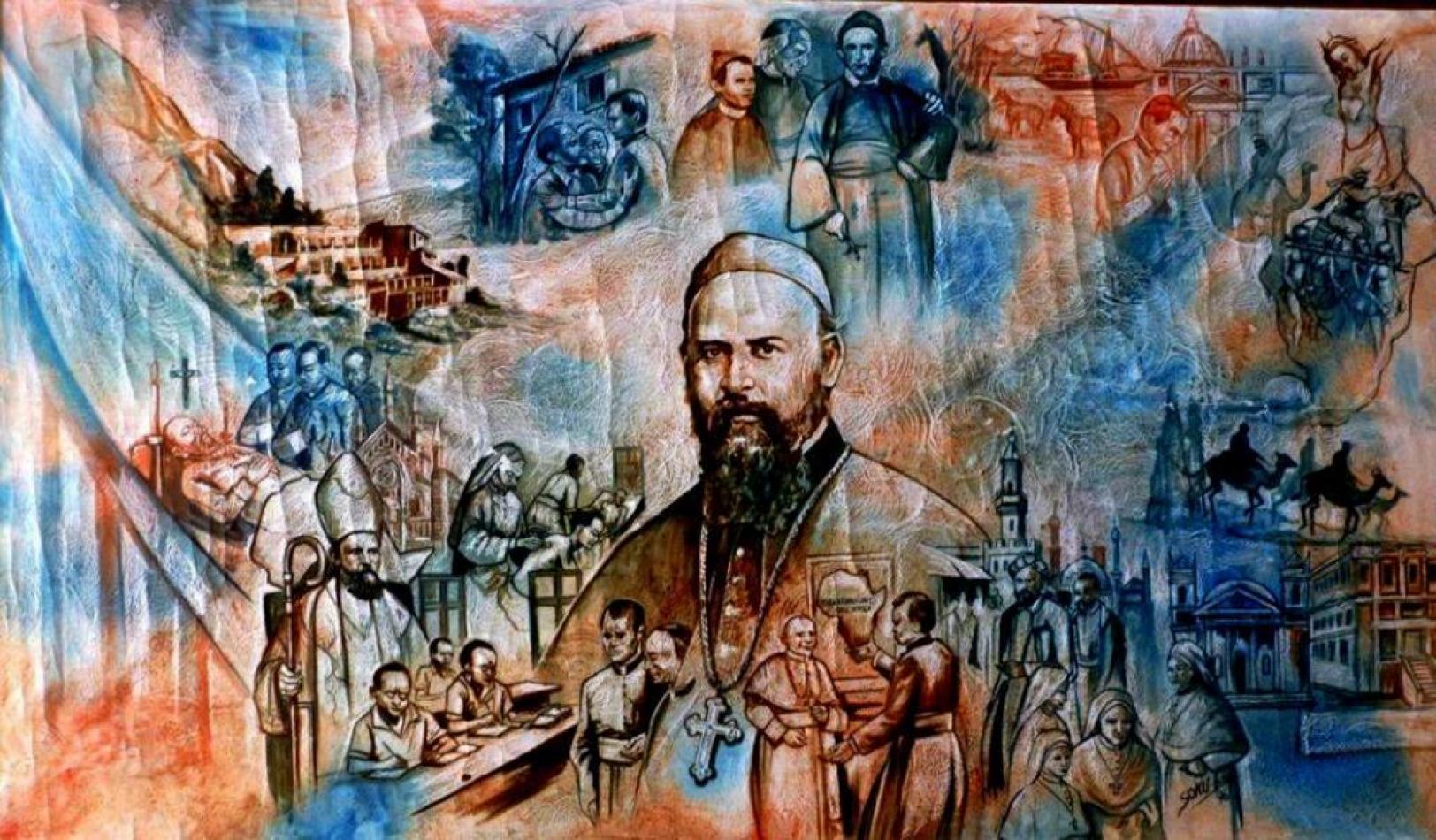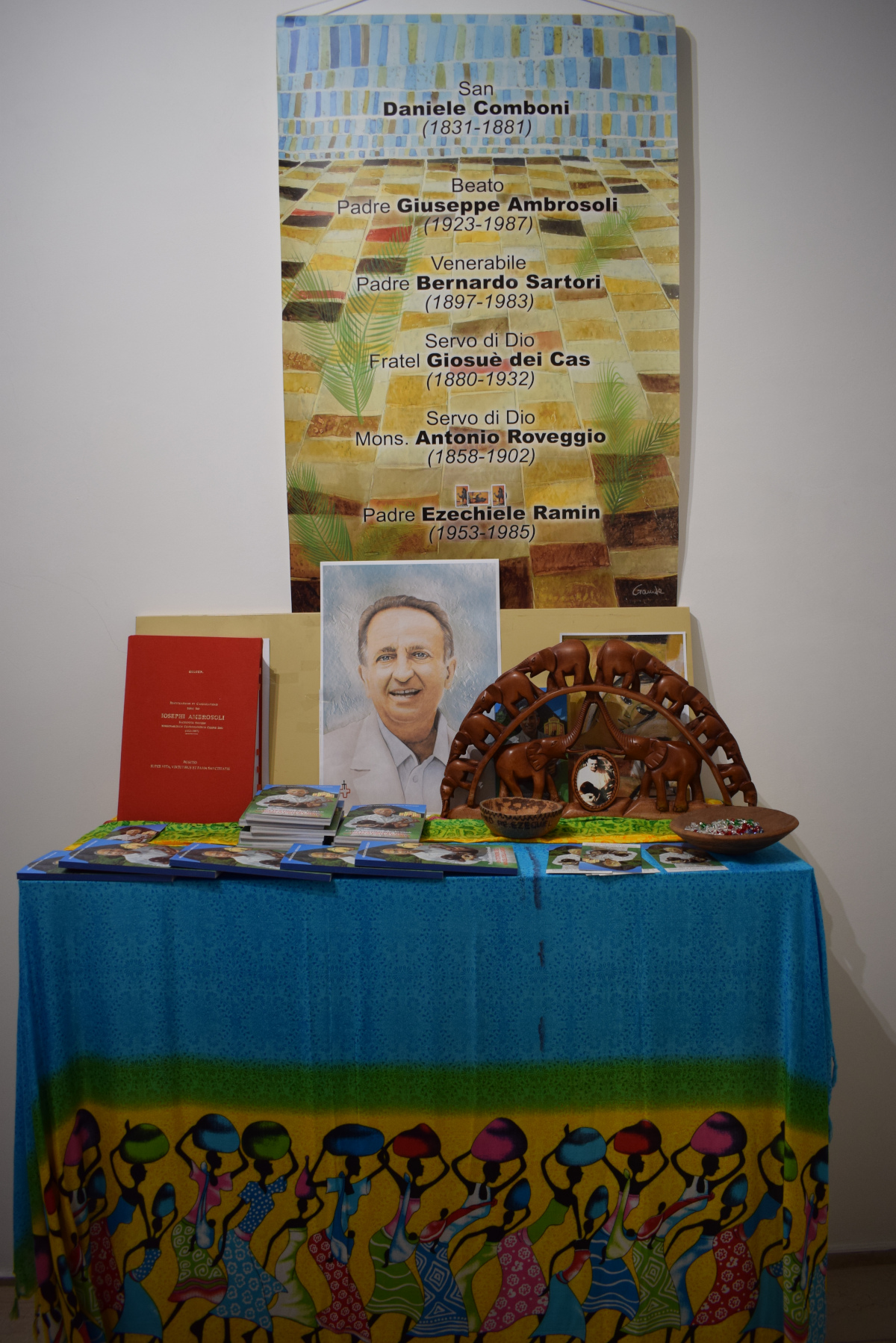Daniel Comboni
Comboni Missionaries
Institutional area
Other links
Newsletter
Sunday, June 12, 2022
We have before us this grid (today we should say “jigsaw puzzle” as the painter who painted it intended) of five of our Combonian missionaries, whom the local Churches, and then the Institute, have proposed to have examined and whom Christ's Church has agreed to evaluate as eminent examples of missionary holiness. The aim was to place alongside Comboni qualified examples of missionary being and doing.
In this tapestry, the missionary charisma is therefore at the center. These faces really want to represent the complexity of our missionary family, spread across all continents, and moved by the spirit of our Founder and Father. I think the first to be happy about this visionary grid is Comboni himself. A vision, therefore, to be kept always before our eyes, in our minds and in our hearts, such that it can be continually contemplated and proposed, feeling how great is their proximity and their missionary credibility.
1. Moments on the road to definitive consecration
At what point are these special companions of ours on the path of the twofold Canonical Process "on the virtues" and "on martyrdom"?
For the Causes that concern us, these were and are the results. We concluded the Cause of the martyrs of Paimol (Uganda) with Beatification on 20 October 2002 and then the Cause of Comboni with Canonization on 5 October 2003. Subsequently, the Postulation was able to better focus on some members of the Comboni Family, eminent for holiness of missionary life and significance of evangelizing praxis.
First of all, the Cause of Fr Giuseppe Ambrosoli, which was opened in Gulu in 1999. On 20 November this year it will conclude with the Beatification in Kalongo, Uganda.
Previously, in 1998, the Cause of Fr Bernardo Sartori had been opened in Arua and today, with the approval of the Positio, which took place on 13 December last year 2021, an important step has been taken with the declaration of his Venerability, i.e. the declaration of the heroicity of his virtues from the missionary point of view.
Then we have the Cause "on the martyrdom" of Father Ezekiel Ramin, opened in Rondônia (Brazil) in 2016 and which is in an interlocutory phase because in March of this year 2022, the theologians' judgement was not uniform: 2 favorable and 7 suspensive. Not bad at all, then, but worrying, because it needs a qualified majority to pass: 2/3 + 1. Generally speaking, the two points made by the Promoter of the Faith are: the first against “odium fidei” (not intended as “hatred against the values of the Kingdom of God”, which has emerged insufficiently and the second against "certain aspects that suggest a social commitment that is praiseworthy but difficult to frame in the perspective of a Christian personality ripe for martyrdom". In fact, three months after the vote of the theologians, we still do not have in our hands the reasons for blocking the trial. Perhaps because Ezekiel was disobedient? Perhaps because he was reckless? Perhaps because he was not identified as a priest? Perhaps because he was killed as a political lider? Perhaps because he was a social martyr? Perhaps because the latifundium, as it was being configured in those 1980s in Brazil amid injustice and violence, cannot be configured as an insult to the Gospel? For our part, we have answered all these objections. However, we feel we can say that there is a frontal attack on the Church of Vatican II and the attempt at Reform introduced by Pope Francis, especially on ministeriality and synodality, on the protection of the environment: Enc. Laudato si' of 2015 and on fraternity and social friendship: Enc. Fratelli tutti, of 2020.
Finally, about the situation of the last two Causes. That of Bishop Roveggio, resumed in 2004, will be presented to the Congregation for the Causes of Saints in Rome towards the end of this year 2022. That of Brother Joshua Dei Cas, which began in Sondrio in 2015, is still at the diocesan stage, waiting for the three Historical Experts to deliver their Vows.
2. A threefold reading grids
At this point, we can say that we need a convincing change of language because these are not 'your saints', as we often hear, but are 'saints' who belong to us in all respects because their Causes enrich the charism to the extent that they highlight peculiar characteristics of being and doing mission.
Concretely, I choose a threefold key to interpretation: first, the new or in any case indispensable aspects of evangelization highlighted; then the "gravitational center" from which everything takes consistency; finally, typical attitudes, still significant in today's context.
I will summarize for at least two of them. The new aspects. For example, for Ambrosoli, to name but one, it is the close union between kerygmatic proclamation and social transformation (for him it meant his service as a priest and as a doctor closely connected). For Fr. Sartori, it is the vocation "ad gentes" lived by him in a hermeneutic circle: as a gift of the local Church to the Institute – as a gift of the Institute to the local Church in the sense of openness ad gentes – and finally as a communion with the local Church to the end in the sense of a communion between structure and charism etc. The gravitational center: that is, the impossibility of living and speaking of mission without a center of values. For Ambrosoli it is the love of God lived in an apostolic, Christological and Trinitarian key: "It is not enough that others call me Christian Democrat. They must feel the influence of the Jesus I carry; they must feel that in me there is a supernatural life that is expansive and irradiating by its very nature”; “I must try to impersonate the Master when he cured the sick who came to him”; “We must enter the circle of the Trinity”. For Sartori the value center is the Eucharist as Sacrament and as presence and Marian spirituality: “Father Sartori let yourself be loved! Let yourself be carried by love, taken by love. Let yourself be impressed like a film, with a humble correspondence and a living and immediate faith"; "If the Eucharist does not throw us out of the cenacle, out of our placid and reassuring devotions, we waste that food". "If one abandons the Mother, one no longer understands the Son". The goal for Sartori was always: first we form the living Church and then we build the church of stone. Typical attitudes (for Ambrosoli, his symbolic sentence is sufficient: “God is love. There is a neighbor who suffers, I am its servant”; for Sartori: “the challenge of a man on his knees”).
I leave it to you to discover the qualities of each one.
3. Finally: a proposal
In light of all that has been said, we have a proposal. You have seen the tapestry, in puzzle form, at the entrance to the Curia Chapel. We would like to accompany it with a book entitled: 'Fellow travelers today, exemplary and inspiring'. The book is intended to represent the awareness of a common responsibility towards the whole Institute: a missionary charisma to be transmitted through the real faces of some brothers whom the Lord has given to our family. A stimulus to know, internalize and pray.
Technically, it is an instrument with a first biographical part and a second part illustrated by symbols that translate the Comboni missionary values that inspired the life and actions of these five confreres. We use the painter Umberto Gamba for the composition and graphics and also of intercultural symbols. Our aim is to offer each of our houses, in the different languages of the Institute, the possibility of a tapestry with the significant faces of our Comboni missionary family and a common typographical base and texts that can be translated, adapted to different circumstances, first interiorized by us and then also disseminated.
We are convinced, and this is the real purpose of our proposal, that all the houses of the Institute should have the tapestry and the explanatory book to create the awareness that these our Causes guarantee a common good, aimed at proposing specific values that make the Institute a body rooted in identity values, capable of inspiring new attitudes in the face of a changing reality. Therefore, these brothers represent, first of all, a challenge to preserve with care and love the historical missionary memory of the Institute and alert us to the danger of a lack of awareness of our roots and a weak sense of identity, and, above all, they invite us more and more to "raise the bar" and to reconsider "holiness" as the high measure of our life and our evangelization (cf. LG ch. 5).
I will end here and not dwell on the aids, both digital and printed, mentioned in the full Postulation Report. There is something for everyone.
Heartfelt thanks to all the Chapter members.
Fr. Arnaldo Baritussio
Postulator General

